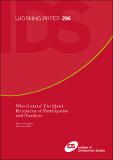| dc.description.abstract | Participatory approaches and methods can generate quantitative as well as
qualitative data. Mainly since the early 1990s, a quiet tide of innovation has
developed a rich range of participatory ways, many of them visual and tangible, by
which local people themselves produce numbers. The approaches and methods
have variously entailed counting, mapping, measuring, estimating, valuing and
scoring, and scaling, together with comparing and combinations of these, and have
had many applications.
The methodological pioneers in going to scale in the 1990s rarely recognised the
significance of what they had been doing. The pioneers of the 2000s have shown
ingenuity, skill, patience and courage, sometimes in the face of opposition driven by
conventional reflexes. Participatory numbers have been taken to scale most notably
through participatory surveys with visuals and tangibles, through aggregation from
focus groups and through wealth and wellbeing ranking. There have been breakthroughs
in producing national statistics, and also on subjects and with insights
inaccessible through questionnaires.
Statistical principles can be applied to participatory numbers.1 Ways have been
found of overcoming the vexing problem of commensurability between
communities. As with all ways of finding out, there are trade-offs, in this context
notably between participatory open-endedness and standardisation for
comparability.
The question ‘who counts?’ raises issues of ownership and power. Participatory
Monitoring and Evaluation (PM and E) has taken many forms, with varied degrees
of ownership and empowerment. Whether participatory statistics empower local people is sensitive to official attitudes and acceptance and whether these lead to
changes in policy and practice that make a real difference. Questions are raised of
the mix and balance of extraction and empowerment, and whether and how the
quiet revolution of participatory approaches and methods can get the best of both
qualitative and quantitative worlds.
Keywords: empowerment, innovation, methods, participation, statistics, qualitative,
quantitative. | en_GB |

